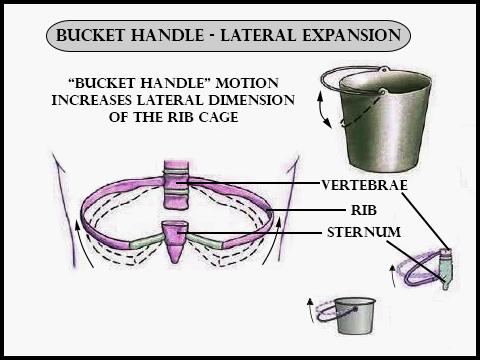
Which ribs show bucket handle type movement
A) Rib No. 1-2
B) Rib No. 3-5
C) Rib No. 6-10
D) Rib No. 11-12
Answer
509.4k+ views
Hint: Bucket handle movement is the movement which causes the change in diameter of the thorax transversely.
Complete Answer:
In humans, the vertebral column is dorsally placed and comprises 26 units called vertebrae. The human chest cavity has important organs - the heart and lungs.
A ribcage protects these vital fragile organs. In humans, this rib cage consists of 12 pairs of ribs. Each rib is a flattened bone which is dorsally connected to the vertebral column and ventrally connected to the sternum.
This connection to the sternum may be direct in case of true ribs, indirect in case of floating ribs, and absent in case of false ribs.
The bucket handle movement of the ribs allows the thorax to transversely change in diameter. The ribs generally move around two axes.
The anterior part of the ribs is about 4 centimeters lower than the posterior part and the middle of the rib is lower than both the anterior and the posterior end.
The movement of the vertebral joint at rib 6 to rib 10 is about the anteroposterior axis this results in raising and lowering of the middle of the rib thus causing the bucket handle movement.

Note: Rib 3- 5 have a pump handle like movement, Rib 11- 12 have a caliper type movement. Rib movements are important for the movement of the upper portion of the body, the range of motion would be extremely limited and rigid without these movements. The bucket handle movement is responsible for breathing as the intercostal muscles bring about this movement by contraction and increasing the thoracic volume.
Complete Answer:
In humans, the vertebral column is dorsally placed and comprises 26 units called vertebrae. The human chest cavity has important organs - the heart and lungs.
A ribcage protects these vital fragile organs. In humans, this rib cage consists of 12 pairs of ribs. Each rib is a flattened bone which is dorsally connected to the vertebral column and ventrally connected to the sternum.
This connection to the sternum may be direct in case of true ribs, indirect in case of floating ribs, and absent in case of false ribs.
The bucket handle movement of the ribs allows the thorax to transversely change in diameter. The ribs generally move around two axes.
The anterior part of the ribs is about 4 centimeters lower than the posterior part and the middle of the rib is lower than both the anterior and the posterior end.
The movement of the vertebral joint at rib 6 to rib 10 is about the anteroposterior axis this results in raising and lowering of the middle of the rib thus causing the bucket handle movement.

Note: Rib 3- 5 have a pump handle like movement, Rib 11- 12 have a caliper type movement. Rib movements are important for the movement of the upper portion of the body, the range of motion would be extremely limited and rigid without these movements. The bucket handle movement is responsible for breathing as the intercostal muscles bring about this movement by contraction and increasing the thoracic volume.
Recently Updated Pages
Master Class 11 Economics: Engaging Questions & Answers for Success

Master Class 11 Business Studies: Engaging Questions & Answers for Success

Master Class 11 Accountancy: Engaging Questions & Answers for Success

Questions & Answers - Ask your doubts

Master Class 11 Accountancy: Engaging Questions & Answers for Success

Master Class 11 Science: Engaging Questions & Answers for Success

Trending doubts
A boat goes 24 km upstream and 28 km downstream in class 10 maths CBSE

Why is there a time difference of about 5 hours between class 10 social science CBSE

The Equation xxx + 2 is Satisfied when x is Equal to Class 10 Maths

What is the full form of POSCO class 10 social science CBSE

Change the following sentences into negative and interrogative class 10 english CBSE

How do you prove that the diagonals of a rectangle class 10 maths CBSE




